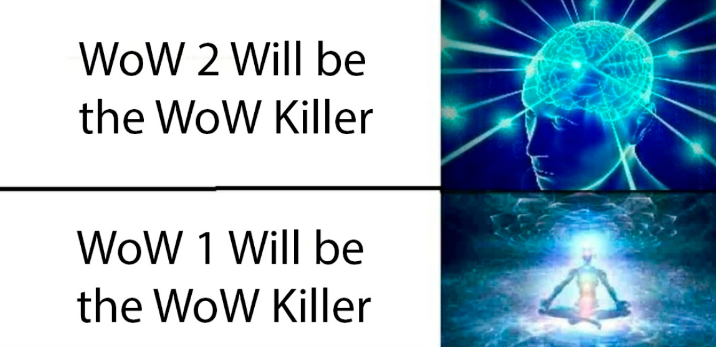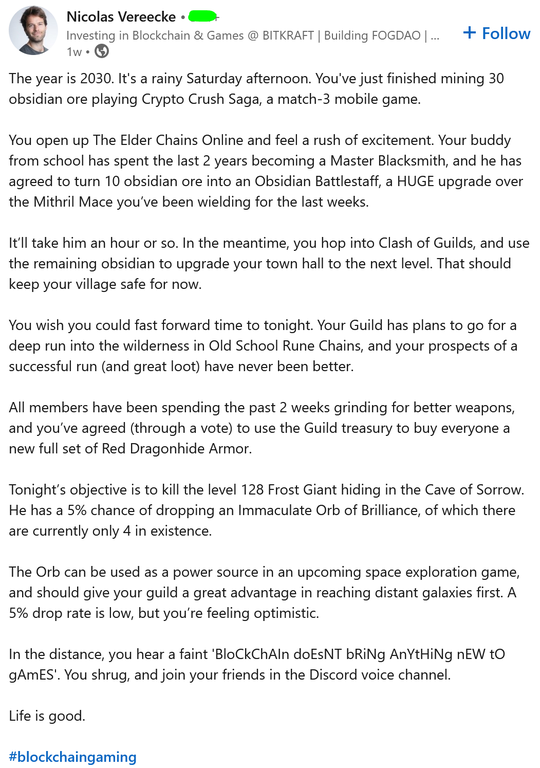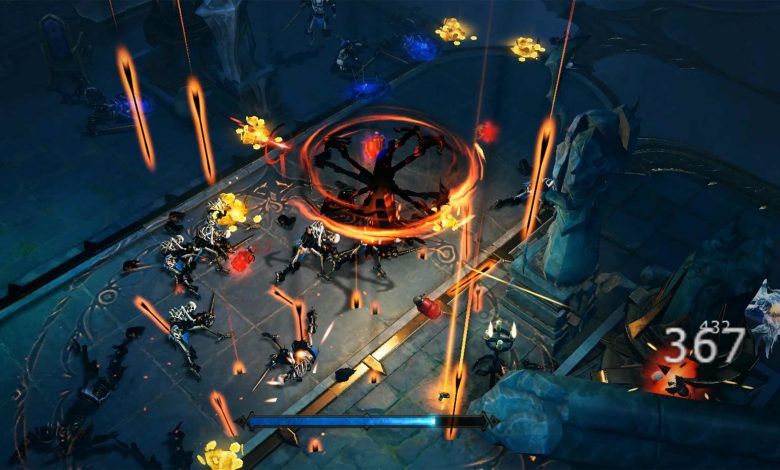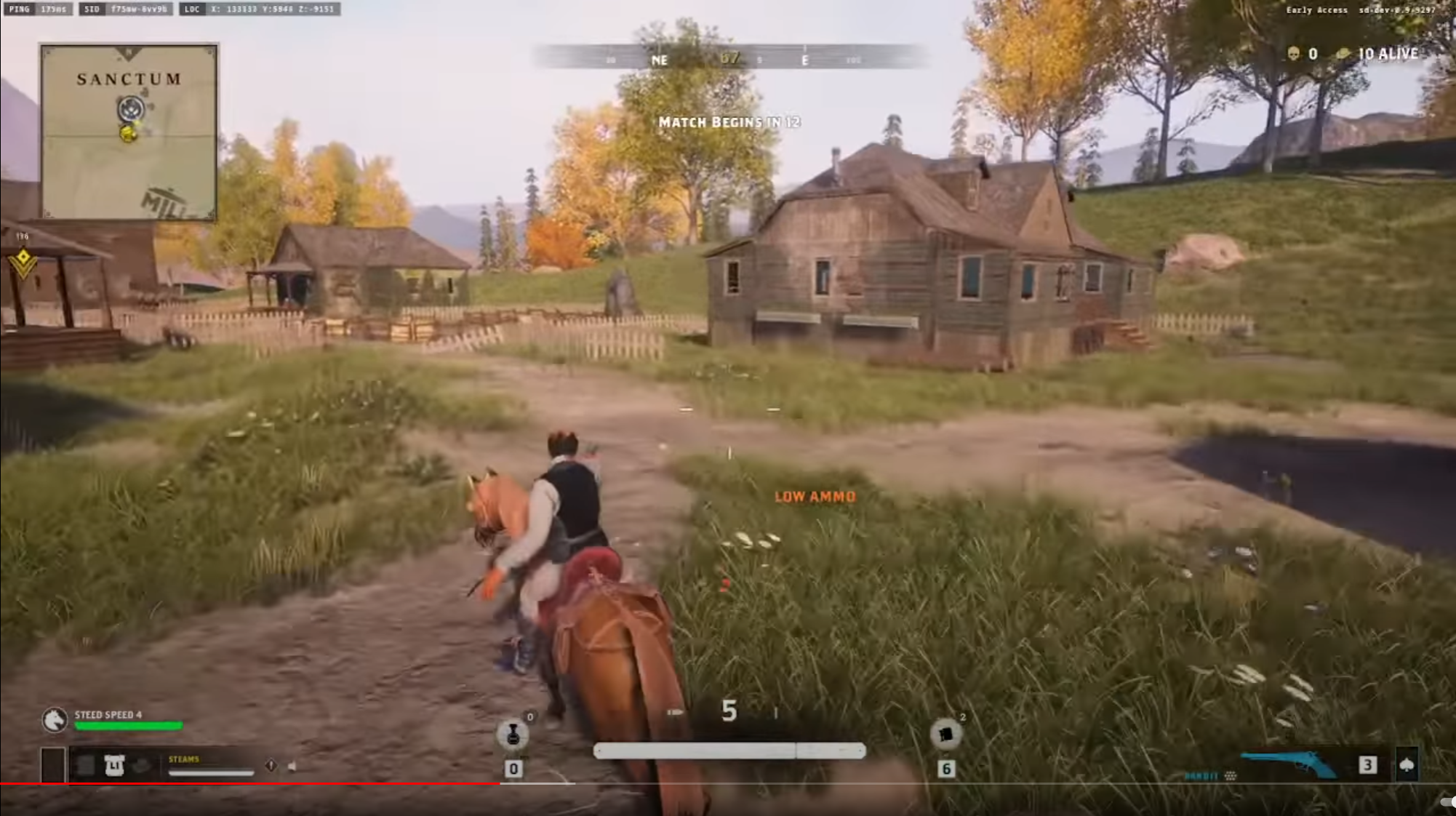June 9, 2022
WritingGame Design Mimetics (Or, What Happened To Game Design?)

Writing for TANK magazine in 2019, Josh Citarella mused on how WoW Classic tied into Mark Fischer’s idea of “the slow cancellation of the future” (aka “where are my hoverboards”) — its release acting as further evidence of the collapsing gap of space between cultural time (cultural cycles) and nostalgia.
I tend to agree with his position here, and have adopted a refrain I like to throw around now — “culture has stopped”. Cirtrella points to the collapsing gap between items that generate culture and items that can be (nostalgically) reflected upon, especially as “The future has been foreclosed [and] the present is intolerable.”
WoW nostalgia, monetarily leveraged through Activition Blizzard’s release of WoW Classic, feels (and is) a regressive moment for games, the biggest item in a trend that now sees nostalgia being levied for even smaller cycles as, even just a week ago, Activision Blizzard announced a remake of Call of Duty: Modern Warfare 2, a game barely a decade old. Citarella closes out his piece stating “Soon the window of nostalgia will grow so narrow that it shuts altogether. And then cultural time will start to move in reverse.”
(Right before I published this piece, a trailer for The Last of Us remake leaked. This is a remake of a game less than a decade old)
Citarella’s piece was on my mind when I read the rightfully disparaged Linkedin thoughtpost that was circulating this week:

There’s a lot of really great stuff in here that is worth making fun of, but the thing that hit me hardest was the actual conception of what game design would look like in 2030. It’s got:
- Match 3
- Basic Crafting (Raw materials to Weapons)
- Gear Progressions
- Building Levels / “Settlement Building”
- Persistent Multiplayer
- Raids
- Grinding
- “Dragon Armor”
- Monster Levels
- Drop Rates
- Digital Scarcity
In imagining the future of games in a decade, the only design ideas Nicolas Vereecke could come up with were mechanics and systems that have been around since the inception of pc gaming and in some cases console gaming itself. For an investor that sees themself working at the bleeding edge of what’s possible with gaming, this is fucking depressing.
This impulse extends beyond Vereecke though and into games’ wider landscape — thinking of Citarella again, it seems like our conception of a “design future” of games has effectively stopped. Our ability to think of games with systems and mechanics beyond what is already knowable seems like a lost cause. As Citarella says, “culture has been locked in”.
It’s a trend that’s easy to see when looking at the most played games on Steam — largely well made first person shooters, sequels, and games that could be described with some version of “It’s like X but Y”. It is possible for something to permeate the collective conscious of Steam even if only for a moment, but these splashes are quickly absorbed, mined for parts, and forgotten (another recent example, now copied and copied again). I think often of the article written by SteamSpy creator Sergiy Galyonkin, “Your Target Audience Doesn’t Exist”
1% of Steam gamers own 33% of all copies of games on Steam. 20% of Steam gamers own 88% of games. If you’re developing a downloadable game for Steam you’re not even fighting for 135M of its active users, you’re fighting for the attention of 1.3 million gamers that are actually buying lots of games. The 1% group.
To be clear, this is a precarious arrangement for game developers, a cloud allocated and preemptively situated over every game in a way atypical to other “high cost” media — in film, the highest grossing (ie. “seen”) movies are often the ones with the biggest budgets. You can launch a multimillion dollar game on Steam and the algorithm can bury you indefinitly 1 hour after launch.
This precarity lends games a hefty design conservativatism, a far cry from Citarella’s calls for a “progressive image of the future”. Hence as game production budgets balloon in size to meet the growing content demands and expectations of players, so too grows the hedging of the game to buffer itself from potential ruin.
Said differently, games are forced to be legible to players. This isn’t a call for radical experimentalism (2) but to simply state that the cost to make games (due to a large amount of factors) is steadily increasing, and as such there is a proportionally growing interest by the powers that be that those games turn a profit. With little flex on things like price (proposing games should cost $70, $80, or more leads to general uproar, despite being something that should totally happen), games are forced to internalize this economic burden on the process of production itself.
Fixed costs for things like art, music, and sound effects (the “content”), means that the less “audio-visually experienced” parts of games (aka all the parts of the game that aren’t in the trailer) bear the brunt of this burden the most. Basically, everything else. Even as things like writing and mechanics inform the actual work of the content (Erin Lee Escobedo calls games “systems sculptures”), they are hamstrung in development due to the fact that, if shifted, literal man months/years can easily be lost ($$$).
This again then leads to conservatism - games are defined by their content, and that content is informed by the mechanics, and as content takes a lot of time + money to make, it is in a studio’s best interest to “choose correctly” the types of mechanics that will work for their game at nearly the start of production, as any late shifts in design could produce disastrous results.
But herein lies the problem, over the course of the development of any game, mechanics SHOULD shift. I think often of how Steven Zwahl characterized game development in their post Growth and Regrowth (2-Year Dev Retro)
A good systemic game — something dynamic and inter-connected — is going to be improvisational. Threads will come and go, join at strange angles. You will have to cut them to keep the shape correct. It’s necessary to have a good idea of how the game at the end will make you feel — how it will play and what that will say — but many threads must be found along the way. Some visuals, some AI behaviors, some player actions must be summoned mid-way, built up, and inter-woven. You will make something, find out it almost works, and change a neighboring thread to bring out contrast.
If you want to give a AAA games producer a heart attack, send them that. This is game design as it’s meant to be, ebbing and flowing with the process of production itself to solidify on “the best idea”.
However, given the listed constraints above, enacting this process for games of any matter of scale is painful and nigh impossible. A game that totally shifts in tone and design halfway through production is what GDC Failure talks are made of. It’s one of the things that introduces crunch conditions. Etc. So where does this leave design?
It’s here that I introduce the title of this article, something that sounds more thinky than it is - “Game Design Mimetics”. If the role of mechanics design in a game is to best serve the content of the game, be legible to the player, and not introduce too much uncertainty into the middle of a production, the simplest answer to “what should we do about the design” is to just “copy what already works”.
“What already works” is a fundamentally conservative and nostalgic lens through which to view cultural production. Looking at “what already works” rejects an idea or potential of progress, and instead narrows the scope of possibility of a medium to only be capable or remediating its greatest hits. It lifts up past achievements as useful barometers of present success, and, to quote Citarella again:
Trapped in infinite additions to the Star Wars universe, these films don’t feel so much like a generational marker as they do an inescapable loop designed to dislodge notions of historical thinking
The past here isn’t looked at as the past, but instead as the metric by which to hold directly against considerations for the present. The constant backwards facing view as the rubric by which to create the future acts as a collapsing mechanism for possibility. It’s what limits Vereecke’s conception of 2030 to be filled only with old ideas.
Not only this, but it distorts the nature of the cultural objects (games) themselves. Keith Burgun touched on this distortion in his recent piece on “Aestheic Gacha-ism”:
The core of my conception of aesthetic gacha-ism is the commodification of games: both in how they are produced, the rules, the experience, the way it’s talked about. At nearly every level, the experience of games gets put more and more onto an assembly line, alienated from human experience, connection and meaning.
A game production environment that prioritizes safe choices and a retroactive lens will slowly dull its ability to think outside of a slowly narrowing field of possibilities. Keith is specficically talking about mobile game-style gachapon (“gacha”) mechanics here, meant largely to drive player retention and bleed players of money, but the thrust of the article is also about how this style of design has started to leak into console/pc games production - an effect one could potentially anticipate as the field of possible “acceptable” game mechanics for all games gets slowly squeezed by a memetic desire to achieve the success of the past (and whats more successful than Angry Birds, Clash of Clans, etc.)
Keith also produces a list of signifiers of aesthetic gacha-ism that are useful to look at
- Extrinsic-reward driven. A strong valuing of metagame over the basic gameplay.
- Elements feel copy-pasted a lot, and/or “subdivided” to increase length. Designed to be played for thousands and thousands of hours, but in a way that feels extended rather than as a natural byproduct of its basic gameplay.
- Compulsion-driven design. Extremely simple and repetitive gameplay, designed to trigger compulsion in people rather than engagement.
- The (dreaded) crafting system. Notably a crafting system hits two of the above points simultaneously: it is both the “subdivision” of upgrades, in that there’s usually tons of smaller items that you can and must craft frequently to get the same effect as “finding a new weapon” in a game pre-crafting systems, but also in the ingredients scattered all around the map, we get a compulsive, repetitive, click-click-click dopamine drip.
- Commodified quests. A programmer built a nice pipeline for quests, and disparate writers and teams built dozens and dozens of quests, almost all of which fit nicely into those parameters.
- More and more things “level up” in some way. You’re always a moment or two away from something leveling up.
The key unifier of these systems is that they are meta-design, design that doesn’t necessarily have a content component (content is expensive!), but instead crafted to invoke Errant Signal’s potent pandemic postulation:
“I’m not really playing games. I’m using these grinds to give me the sense of playing games”
It’s a design style afraid of design, so conservative to the point that the actual “design” is a forgone conclusion (being likely composed of many of the things mentioned in Vereecke’s list), and that the “design” work itself is managing the player experience through those (set) mechanics. This is the collapsing window of possibility directly manifested.

Keith goes a step further to characterize a focus on these sorts of mechanics as “games increasingly becoming ads for themselves”. If developers are making a game that players already expect (“legible”), the work to introduce a game is not to present players a new design space to tinker in, but a meta design space meant to present a novel way of interacting with mechanics and systems players already know.
Re-reading Galyonkin’s piece for this article, I was actually surprised to see him, in 2015, mention a similar idea:
I’d go as far as to say that each multiplayer game is a cultural self-reinforcing phenomenon, relying on its perceived popularity more than on its market share.
It’s as if there is effectively “design consensus” - “we figured out games everyone, good job!” And if you look at the numbers, maybe this is true. Keith opens his piece by even saying that despite all the complaints about gacha, these games still enjoy large player bases and large pools of income. The meta-designed games still drive players as they pivot around the foci of the game itself. Kyle Chakya quotes Kate Eichhorn’s idea of “content captial” in his piece on two books about the internet in the New Yorker, and Kate’s idea threads well into this pheonenon, albiet through the lens of social media “content”:
Cultural producers who, in the past, may have focused on writing books or producing films or making art must now also spend considerable time producing (or paying someone else to produce) content about themselves and their work.
A famous singer may generate more income from a sponsored post on Instagram than through album sales of their chart topping album. People already famous from producing “works” are now focused on meta-work, their cultural capital gained from doing that work in the first place now refocused on producing content related to their strongest signifiers. Every great design idea of a game in the past is now the canon, with meta-design pivoting around that canon in a forever attempt to reframe the canon just enough to appear new.
Chakya elaborates a bit on Twitter:
“Content” — the constant, homogenized, indistinguishable flow of digital detritus — doesn’t usually constitute the creative product or art itself. Content isn’t the goal (who wants to “create content”?) but it’s what is needed to succeed online. Hence all the cultural creators you admire having to just shitpost all day like everyone else, instead of writing novels or making music. It might even be that those who are most successful are those whose “content” aligns the closest with their perceived creative output.
It’s a memetic desire to remediate past success through a new lens that is legible to the platform and appetites to consumers. Everyone is now “famous for being famous”. Diablo Immortal is notable because it’s a Diablo game, not because it delivers any of the design innovation that drove Diablo to success in the first place (3).
I’ll close out this sort of meandering piece on musing about two specific games that debuted in some meaningful way this past week, V Rising and Grit. V Rising is a top seller right now on Steam, and Grit, through not released, enjoyed (?) a lot of visibility this past week due to an incredibly cringe playthough.

Grit is an NFT/Blockchain game, the potentially first of its kind, and is being very loud about that fact to attract all the blockchain/nft boosters. And yet, just like Vereecke’s future, someone breathlessly describes it, the supposed marker of the future of games as:
“Think Wild West. Think Battle Royale. Think Fornite. Zero-build Fortnite plus whatever your favorite battle royale game is, and this is what you get.”
This is presented as a good thing. A great thing even. That the future of games is just games you already know and love, but also with NFTs. Grit is largely getting shit on for being an NFT game, but this memetic desire to be legitimized by mechanics and systems already legible is also present in the recently released and lauded V Rising.
I read good things, reviews were positive, the game was cheap, so I picked it up. After a little over an hour, I don’t think I’ll play it again. Similar to Grit, it’s marked by all the same appeals to legibility and even in a way more than Grit, has some of the Gacha aesthetic Keith talks about.
The crafting is more of the same “rock-punching” gameplay to gather lumber. You build stuff in the world from a half assed list of build options that require said materials. You build things to refine those materials. You roam an open world ARPG game to find enemies and rarer materials. Your character has stats, and inventory, and skills. “Gear Level” isn’t just an abstract concept but a literal number. Sound familiar?
I get depressed playing stuff like this. The worst part is that the game is Fine. Stunlock Studios did Fine. “Fine” in the way that, NFT bullshit aside, Grit is probably also “Fine”. “Fine” in the way Diablo Immortal is Fine. We’re in a deluge of games that are “Fine”. This is design conservatism and design mimetics flourishing - everything is “Fine”. Everything is supposed to be Fine, because that’s what these games are trying to be - the intersection of your favorite set of Steam tags, manifested with Fine art, Fine mechanics, and a Fine story, produced to help you not have to think too hard about what you’re doing.
I had a small conversation with Michael Thomsen on Twitter a few years ago, and he brought up a point I thought was apt:
I think the brief window where videogames were at the heart of play culture is gone, kind of like the way music outgrew chamber orchestras and symphonies. People growing up are just as happy to play with tiktok or snapchat, and dont need it to be this rigid, baroque “videogame” thing
I don’t want to chalk this up to design mimetics, but I also do want to chalk this up to design mimetics. Games are becoming increasingly bad at advocating for themselves, especially as the difference between what’s “old” (WoW) and “new” (WoW classic) feels inscrutable - Where is the place for someone who doesn’t like WoW? A backwards facing cultural lens with a closing window of possibility will inevitably push out everyone, leaving videogames as only a rough imprint on time, their cultural outcomes instead disseminated through social networking apps, “sparking joy in software”, “multiplayer collaboration”, and “engagement”.
Footnotes
1 A sad part of growing up is realizing How the World Works. With this in mind I wanted to say a little bit more about what Vereekcke is “doing” here. The references that are dropped are obviously evocative in that they invoke known quantities like Clash of Clans, Candy Crush, Skyrim, etc., with the (hopefully) implied idea that these won’t be the actual games that exist, but that it would be stuff Like This. However this is probably not the case. Pitches like this get circulated, and then the language in those pitches becomes truth and then must be delivered. This gives you a lot of games that, when pitched, are going to be “kind of like Fortnite but X” but end up being exactly like Fortnite.
2 One thing I really don’t like about the general direction of “indie” games is that they seem more concerned with aesthetics. It’s often aesthetic progressivism mixed with design orthodoxy. A beautiful hand-drawn art style for a puzzle platformer less complicated than Mario.
3 In A Theory of Fun For Game Design, Ralph Koster talks about the concept of “Game Topologies”. Basically, a way to look at games that strips them of all their art, music, sfx, etc. (the “trailer” stuff) as a way to actually “look” at what a game “is”. There’s a fun/sad thought exercise that you can do for games as well, which is to take a similar approach but stripping away the “meta” elements of games’ production. Look at Diablo Immortal like it isn’t a game being released by Activision Blizzard - imagine it was a nobody studio, is it still interesting? Would you still buy it?
There’s a lot of other dimensions to the stuff I brought up here, but one I think it could be worth expounding on in the future has to do with how a collapsing conception of the future also drives conservatism in appetites of games by consumers, not just developers. I spoke about that a bit here.
Going to keep track of some other pieces that are also coming out around now that act as sort of ancillary and similar reads:
https://spikeartmagazine.com/?q=articles/downward-spiral-taste-figures-images
https://experimentalhistory.substack.com/p/pop-culture-has-become-an-oligopoly
Date
June 9, 2022from Hacker News https://ift.tt/5ZkRXax

No comments:
Post a Comment
Note: Only a member of this blog may post a comment.